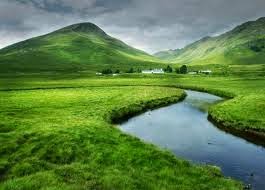For composition and framing :
- Use the space wisely
- Keep the camera level
- Make sure you draw attention to subject of photo
I learned that good composition is a key element to capture a good photographs... However, the good composition is hard to be defined.
Plus, there are 5 good composition guideline that i learned in photography :
1. Simplicity
2.The Rule of Thirds
3. Lines
4. Balance
5. Framing
I will go through one by one what it meant by its 5 elements of composition.
1. Simplicity
- Look for ways to give the center of interest in your pictures the most visual attention.
- One way is to select uncomplicated backgrounds that will not steal attention from your subjects.
- For example:
"Just One Subject: A frame that has just one attractive subject and not a thing else—no clutter in the background and nothing else in the foreground—can help highlight the subject dramatically. Some examples: a beautiful white flower with completely dark background, portrait of a person, bird or animal with uniform background that contrasts the colour of the subject, etc. Do keep in mind that it is important in such cases that the subject be charming in itself. A colourful bird or a beautiful flower has the power of attracting the viewer with ease. "
Source : http://travel.paintedstork.com/blog/2011/08/travel-photography-power-of-simplicity.html
5.Framing
2. The Rule of Thirds
- Divide a photo into thirds both horizontally and vertically
- Horizon line should be on one of the horizontal lines
- Place main subject in either 1/3 or 2/3 of the frame
- Use “sweet spots” for perfect placement
- The intersections of these imaginary lines suggest four options for placing the center of interest for good composition
- For example:
 |
| Source: Darren Rowse (2014) |
3. Lines
- Straight lines in a composition to lead the eye of viewer
- For example:
 |
| “Allegro North Peir at Sunrise” captured by Coy Aune |
- The S curve
 |
| Source : http://www.photographyicon.com/line/ |
- There are many lines you can do besides the two lines i mentioned above.You can read more on Leading Lines in Landscape Photo Composition
4.Balance
- Good balance is simply the arrangement of shapes, colors, or areas of light and dark that complement one another so that the photograph looks well-balanced.
- For example:
 |
| Symmetrical Source: Samantha Panzera's Photography |
- However, balance in composition does not mean it must symmetrical all the time.. They can be asymmetrical.
- For example:
 |
| Asymmetrical Source: SyaziMalik (2012) |
- Sometimes you've a object of huge dominance within a scene. While breathtaking on-location, the final picture looks often much less impressive due to uninteresting space around the object.
- Try to find a frame which can eliminate the unimportant and surrounding and focus the view.
- For example:
 |
| Source : Darren Rowse (2014) |
- A frame serves numerous purposes.
- It gives the image depth and helps to give the perception to viewers of it that they’re looking at something that is more than 2 dimensions.
- Use correctly, framing can draw the eye of the viewer of an interest to a particular part of the scene
- Framing can bring a sense of organization or containment to an image.
- This won’t work with every shot - but if you’re after a more ordered or formal feel it can be useful.
- Framing can add context to a shot.
- Frames can also be in the foreground or background of images (although more often than not they’re in the foreground).
In summary, to capture a good photography must master the good key element of composition skills in photography. Well, try to capture a good photo and good luck.. :)
Next week, class we'll be held in studio for an hour and outdoor shooting for the following hours with En. Phuatt.


No comments:
Post a Comment